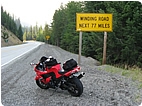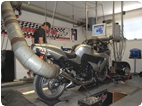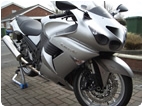So I just purchased a 2009 zx14 with 10k miles on it. Excellent shape cosmetic and seems to run like a champ but I just can't get over the noisy motor...? Is this typical? It's a very distinct ticking noise almost like an exhaust leak on a set of old headers. My previous bikes were a Honda VFR and XX Blackbird and they don't seem to be noisy at all with 3 times the mileage. Every bike has different characteristics though. Anyone have an answer? Thanks
 |
 |
 |
 |
 |
 |
 |
Created on: 01/28/15 06:36 PM
Replies: 65
jheathman
Location:
Joined: 01/28/15
Posts: 18
VicThing
Joined: 07/17/14
Posts: 2402
jheathman
Location:
Joined: 01/28/15
Posts: 18
RE: ticking noise
01/28/15 8:25 PM
Well that makes me feel somewhat better...like I said she runs like a champ and corners amazing. You guys think I should go ahead and have the valve lashing checked and possibly an oil change just for my own piece of mind. Also what brand oil and weight would you recommend? Previous owner had Castro 1040 4t motorcycle oil in it.
Hub
Joined: 02/05/09
Posts: 13800
RE: ticking noise
01/28/15 9:25 PM
It's a very distinct ticking noise almost like an exhaust leak on a set of old headers.
I would start there at the header bolts. Why? Your first valve inspection is at 15k. Most have extended that service interval without hearing a distinct ticking noise.
Valve tick wise, that's a tight valve and heat cannot transfer in that short of a time. If the gap was wider it takes more time to climb up the ramp to open it. The tighter the gap the less time spent transferring heat.
The heat will crack valves and cause pie cutouts like a triangle chipped off the valve and then no compression. So basically hear the tick, this says heat begins to cook that valve. If you can hear a tick and it's not a header leak, do not wait.
jheathman
Location:
Joined: 01/28/15
Posts: 18
RE: ticking noise
01/28/15 9:48 PM
Appreciate the info hub. Used dealer I purchased it from insured me they had ran a compression test for all cylinders and the bike was perfect. You can't ever trust these guys though. I've only put 100 miles on it since purchased. Do you think if it is valve tick there would be a chance for severe damage or if I haul it in now I'll be fine? Also if this info helps rule things out any better the ticking seems to come and go with rpms....or I can't hear it because motor is spinning faster.
Hub
Joined: 02/05/09
Posts: 13800
RE: ticking noise
01/28/15 11:17 PM
Also if this info helps rule things out any better the ticking seems to come and go with rpms...
Yes, it does rule out the exhaust leak. Usually an exhaust is a constant, the valves are a come and go tick. As far as compression, lots of dust should still be on that noise pad or heat pad. If it looks like sleeves were dragged across that engine booty, where the plugs are, that's a good sign that if still dirty is that engine booty, they did not check compression.
Even though the tick still has miles to go, only way to really find out is an inspection. Having them set loose gets them quieter.
jheathman
Location:
Joined: 01/28/15
Posts: 18
RE: ticking noise
01/29/15 5:45 AM
So please excuse my ignorance, just to confirm I should go ahead and take it in and have valves checked and adjusted if needed? Over time do the valves get loose or tight? What is the point of the adjustment I know there needed but not why? You said having them set loose makes them quieter but I had thought they were supposed to be tight....Again please dumb it down for me.
untamed
Location: RSA
Joined: 08/18/13
Posts: 347
RE: ticking noise
01/29/15 6:19 AM
I know on my 14's when I did pair conversion/block it got a ticking that if you listened when you pull off it increased with the rpm but as you went faster it went away. Are you hearing this ticking even when riding at higher rpm? Or is it when it's idling and you blip/increase the throttle?
Check where ticking is coming from before you give yourself the run around. Like Hub says start at the headers and then work down the motor. Check above the headers on the top of the motor where the pair system sits.
You will find various postings on this forum and probably others regarding the "tick" on the ZX14
Now riding 2014 ohlins ZZR 1400, Z 750, GPZ1100ZX, ZZR1100, Hayabusa, GSXR1000, 2009 ZX14 special edition.
jheathman
Location:
Joined: 01/28/15
Posts: 18
RE: ticking noise
01/29/15 6:24 AM
Untamed that is exactly the characteristics of the sound it ticks at idle and as I accelerate to about 4k rpms then seems to go away....or as I said with wind noise and motor maybe I just can't hear it anymore. I bought the bike and appears to be stock which was what I wanted I was hoping to avoid one that had seen too much strip already so I don't believe anything aftermarket has been done. Also earlier I mentioned the oil, you think it could possibly use better oil the dealer told me it only had 300 miles on it but it looks awfully dark in the view glass.
untamed
Location: RSA
Joined: 08/18/13
Posts: 347
RE: ticking noise
01/29/15 6:50 AM
J, nice bike I had the exact same model and colors.
You will probably have to strip one side of the fairing to be able to get better access to the motor. Preferably righ hand side to see where the ticking is coming from.you will also then be able to see the pair system.(look under rook's tutorials, he shows you how to block off the pair). Check if the pipe coming out of the airbox has been blocked, normally this is done to eliminate the backfire when running with an after market exhaust. If not blocked or removed and the hole system is still in tacked you might find the previous owner had done the mod and had put it back to standard before selling it, without replacing reeds.
As for oil I normally change when it goes dark or every 2500 kms this might be excessive for some but I preferr running with clean oil. What you might find is the dealer drained old oil but never changed the oil filter. For peace of mind ,drain oil ,change filter, fill up with new synthetic oil. This will also make your gear changing smoother.
Now riding 2014 ohlins ZZR 1400, Z 750, GPZ1100ZX, ZZR1100, Hayabusa, GSXR1000, 2009 ZX14 special edition.
jheathman
Location:
Joined: 01/28/15
Posts: 18
RE: ticking noise
01/29/15 6:57 AM
Thanks untamed I have always wanted a 14 but haven't been able to afford insurance. Now I'm 30 and everything seems cheaper. Anyway it's my dream bike and hands down the nastiest thing I've ever owned. Just want to take care of my baby and I have a little ocd. My wife's r6 only has 4k and it's a rattle box and drives my ass crazy but I am finding out that all bikes have there quirks I guess.
untamed
Location: RSA
Joined: 08/18/13
Posts: 347
RE: ticking noise
01/29/15 7:46 AM
You deffnately bought the nicest, baddest , sweetest, meanest bike around. Speak to The guys here, some have a wealth of knowledge and have helped me out plenty.
Enjoy, you're going to have lots of fun
Now riding 2014 ohlins ZZR 1400, Z 750, GPZ1100ZX, ZZR1100, Hayabusa, GSXR1000, 2009 ZX14 special edition.
Rook
Joined: 03/28/09
Posts: 20856
RE: ticking noise
01/29/15 8:08 AM
Excellent shape cosmetic and seems to run like a champ but I just can't get over the noisy motor...? Is this typical?
yes. cam chain rattle and just some odd ticky noise.
Used dealer I purchased it from insured me they had ran a compression test for all cylinders and the bike was perfect. You can't ever trust these guys though.
Agree.
So please excuse my ignorance, just to confirm I should go ahead and take it in and have valves checked and adjusted if needed? ...Again please dumb it down for me.
I doubt you need a valve adjustment at 10,000 miles. I did mine at about 24k and there were only two that were real bad. I think all but one of the exhaust were out of spec but by only a hair. Lots of people don't do this procedure until way past due. The valve ware seems to slow down as the engine gets older. I checked mine about 12000 miles after the first adjustment and they did not change at all.
What is the point of the adjustment I know there needed but not why?
The surface between the valve and the valve seat wears over time. The valve settles deeper into the seat. This makes the valve stem on the opposite end stick up higher. This pushes up your lifter an equal amount higher. Now the space between the cam and the lifter is an equal amount reduced. The cam is closer so it keeps the valve open longer. It also causes accelerated wear between the cam/lifter and the valve/valve seat. The worst effect of out of spec valves is that they tend to burn.
Over time do the valves get loose or tight?
TIGHT as described above.
You said having them set loose makes them quieter but I had thought they were supposed to be tight.
I was told having them set loose will make them more noisy. More space between parts, more tick. There is a specced range you set the valves to. I went for tighter because it is supposed to be quieter and also for performance reasons. To tell you the truth, I didn't notice much change in the tickyness and the performance enhancement of tight intake valves is not something anyone can feel either.
I suppose a loose valve might tick from too much space between the cam and the lifter. The cam would tap on the lifter as it contacted it (maybe). In that case, tightening would solve that problem. A bigger concern with a loose valve would be having the shim fly out. Then you are screwed. Generally, valves do not get loose, though. They get tight. They get quieter, not noisier. Perhaps if they are too tight a tick develops from the valve snapping back into the seat under the increased spring tension? IDK
I guess I'm surmising that ticking might happen from too loose or too tight. I doubt you would be at that stage at 10k miles.
you think it could possibly use better oil the dealer told me it only had 300 miles on it but it looks awfully dark in the view glass.
It's a hot running engine. The oil darkens up pretty quick but if it looks blackish, it has more than 300 miles on it. Yes, fresh oil will make it run noticeably quieter.
I have a little ocd.
We all do.
Does your bike sound noisier than this? Sometimes mine sounds a little noisier in real life than the the vid. I would locate where the noise seems to be coming from first. It could be a cam chain. I doubt it's valves.
Grn14
Location: Montana
Joined: 02/25/09
Posts: 15511
RE: ticking noise
01/29/15 9:44 AM
"ticking noise"...well..in Rook's vid..I hear no ticking.I've had 3 14's now...an 07...a 2012,and a 2013.ALL of em had a light ticking noise going on at various times.I ran my 07 to 24K before I had the valves checked.They were all in spec.My current 2013 with 20K on it has the familiar ....'light tick'(has from day one with zero miles on it).Not anything like something's wrong.Here's an easy test...other than first checking the headers bolts.CHANGE the oil to something thicker.IDK what your temps are where you live...or even the weight of the oil that's now in it.Try some Full synthetic possibly.See what that does.10-40 Motul 7100...try that.Without actually hearing what you're describing...it's VERY hard to determine here on a forum what it might be.Mine 'ticks'...lightly.VERY lightly.My 14's always have.Reading this here...it sounds...normal to me what you're hearing...if you haven't ridden one of these before...and are used to another motor..it could seem not okay...but unless it's sounding like it's really not right...I'd go with an oil change first...after checking the header bolts.
If the bolts are somehow loose...depending on how loose they actually might be...at startup...cold...the noise would be louder(if it was a small 'gap')but would get progressively less as the engine warmed up...possibly stopping altogether.If the 'gap' was bigger...then it would sound pretty much the same no matter what rpm or temp the parts were at at any given time.I think your dealer most likely was honest with you....Hub's advice about looking at the insulator blanket was good.See if it LOOKS like it's been removed.Handprints...not fitting over the head just right...stuff like that.
You did mention the oil appearance...change it out then.
I would guess you could rule out the cam chain....that 'might' only make a sound at start-up when cold...for a couple of seconds....If I put my GoPro cam down in the front of the cockpit there...by the steering stem...I can video the ticking noise....otherwise...I can't really hear it unless I'm listening for it....but it's there....and my headers are fine.
I ride 'always' with ear plugs....when a few times I've not worn em...the motor definitely sounds more...'mechanical'...tickings,whirrings....stuff like that.
Your bike does have the insulator cover on it,yes?If that's removed..it could sound somewhat 'louder'.More metallic.
Again...a mild ticking is normal with the 14 engine.If you aren't used to it...it could sound not okay...MILD ticking.
I think you can rule out a valve problem....never heard of a 14 needing valve adjustments at 10K...never.But it wouldn't be not possible...
Do your other bikes have an insulator blanket over the Valve covers?The Kawasaki motor for these does have mechanical sounds going on.That blanket helps deaden some of this(among other things).Your other bikes might not need it.Kawasaki has incorporated several sound deadening applications inside the motor for this reason.
I can say that when I'm out riding on a day when the temps are like...85-90F...my motor does make more noise at idle.
Vic said..."My only other bike was a VF1000F, back int he 90s with 10-20k on it. I bought my 14R new, 1 mile on the odo. The 14R's engine is extremely noisy and ticky in comparison"...agreed....even the motor sounds are different from the Gen 1's to the 2012's and up.Trying to compare a 2012's sounds to a pre 2012 is not gonna be accurate.Mostly.IMO.
* Last updated by: Grn14 on 1/29/2015 @ 10:35 AM *
jheathman
Location:
Joined: 01/28/15
Posts: 18
jheathman
Location:
Joined: 01/28/15
Posts: 18
Hub
Joined: 02/05/09
Posts: 13800
RE: ticking noise
01/29/15 12:24 PM
should go ahead and take it in and have valves checked and adjusted if needed?
I would but that's just me.
Over time do the valves get loose or tight?
More tight than loose.
1. The valve tip mushrooms out and can go loose.
2. The valve face goes mushroom along with the seat and that moves up and closes the gap.
3. The valve seat is machined into the softer head and the spring is pulling the seat up and that walk up the head tightens the gap. The factory knows about this movement, thus the shim selection.
What is the point of the adjustment I know there needed but not why?
We have 3 common ticks to an engine.
1. I want to eliminate the exhaust tick. I have 2 ticks to go, but you added it goes away so this does not count as a ticking problem. This is for another time.
2. I want to eliminate the valve tick. I may have a burned piston occurring where the skirts or the front and rear of the piston changing direction has lost clearance.
3. I want to eliminate this scenario like I die with a tick and I die knowing my 3 variables and the fuel/spark/compression sitting on the side of the road which is it as I sit in the garage and hear a tick, which is it?
You said having them set loose makes them quieter but I had thought they were supposed to be tight....Again please dumb it down for me.
Loose: This setting is for touring/traffic/wallet economy type riding. Loose has brought on a little bit more burn time. The power stroke is still making power as the gas keeps burning and the valve stays closed. With a loose setting, there is more time in degrees waiting for the exhaust valve to open. There is our torque for traffic, economy, and remember, the more valve sitting there cooling off, the longer it lasts parts wise.
Tight: This setting is more for raggedge racing. The #1 game for racing is faster in and faster out. Just like racing, the faster to the corner, the fastest thru the turn, is the one who opens the throttle sooner. You have a book number with a max-middle-minimum. These are your clearances or the parameter the parts can still function in before major engine work is needed. So, the faster the valve opens, the faster the event. Or, keep watching the exhaust make power and then kill it. It made and ever diminishing stroke happen, but the racer looks for things to happen faster and cuts it off at the peak of forever and you are riding the diminishing grunt longer with a loser valve.
You are going to trick your dealer/mechanic and ask these questions so you have some sort of simple concepts to ask and the answer should be just as simple. On the menu at the barbershop is shim shaving 1-2 and 3. His barber school can only cut your shims 3 ways.
1. Maximum Book Clearance = Best Torque.
2. Middle or Ideal Clearance = Overall Performance.
3. Minimum Book Clearance = Best Top End Speed.
When you go in for the valve and throttle sync, request my valves to be shimmed at setting 1. Of course they may not have the shims, but if you were to 'blueprint' the clearances, the book still says I work within this clearance so I run loose and chase that number. I know the parts are going to move as it wears so I run the max gap within book spec.
* Last updated by: Hub on 1/29/2015 @ 12:25 PM *
jheathman
Location:
Joined: 01/28/15
Posts: 18
Rook
Joined: 03/28/09
Posts: 20856
RE: ticking noise
01/29/15 1:16 PM
"ticking noise"...well..in Rook's vid..I hear no ticking.
Wish I could start it up. I think it has a quiet tick to it. Heck when I started it a few weeks back, it had a LOUD lick and I didn't evenblink an eye until it suddenly stopped ticking whjen it went to slow idle. These things do tick a little bit.
Hub's advice about looking at the insulator blanket was good.See if it LOOKS like it's been removed.
I was going to tell the same thing. If you want to go all out, unfasten the blanket and see if there is dirt on the top. If there's dirt, they didn't take that thing off = NO Valve clearance check. They hate doing those and I've heard of them saying they did it when it was obvious they did not. One guy even taped a hair across the vavle cover and it was still there when he checked (old stiry but I wouldn't be surprised).
I would guess you could rule out the cam chain....that 'might' only make a sound at start-up when cold...for a couple of seconds..
True but if the tensioner is stuck the cam chain might be running loose all the time. I heard of that happening a while back. Is the tick on the RH side engine? That would be the cam chain, probably.
Your bike does have the insulator cover on it,yes?If that's removed..it could sound somewhat 'louder'.More metallic.
I didn't notice a difference with or without.
Dumb question how do i get my rear cowl off...
in case you need help with any others:
FAIRINGS
Ok new question what's the easiest way to get the battery out mine is crap cold weather has zapped it and it seems like all the freaking plastic has to come off to get to it under the tank...?
Take off right forman. Take off battery cover. Don't start it if it's 30° out. Wait until it warms up a bit. ogh, i hate atarting mine when it is cold. Think of all the condensation and unneccary stress on the motor when it's dead cold?? Sup to you. I don't start unless I have to.
dude, you have to check out my tutorials. Click the link up there. ...but don't stop asking ???
Do you have access to a video camera? You could record the ticking, upload to Youtube and we'd know if it was abnormal.
yannih
Location:
Joined: 11/08/12
Posts: 2176
RE: ticking noise
01/29/15 1:40 PM
That's a sweet exhaust tone from your vid Rook.
For me, the perfect smooth powerful growl that's not too overbearing.
Nice...
And I now know where you keep your bike key so look out!
* Last updated by: yannih on 1/29/2015 @ 1:46 PM *
jheathman
Location:
Joined: 01/28/15
Posts: 18
RE: ticking noise
01/29/15 4:25 PM
Ok so reaching in to tighten first set of header bolts on right side of bike and there pretty loose....how tight should they be is there a torque spec? Do they just need to be snug. Also am I correct to presume I will need to pull fairings to do the inside 2...
VicThing
Joined: 07/17/14
Posts: 2402
RE: ticking noise
01/29/15 4:52 PM
Vic said..."My only other bike was a VF1000F, back int he 90s with 10-20k on it. I bought my 14R new, 1 mile on the odo. The 14R's engine is extremely noisy and ticky in comparison"...agreed....even the motor sounds are different from the Gen 1's to the 2012's and up.Trying to compare a 2012's sounds to a pre 2012 is not gonna be accurate.Mostly.IMO.s
Yeah, and that means of course it's the only motorcycle I've ever ridden, worked on, know about, heard, etc. This might the dumbest thing I've heard in a while.
Hub
Joined: 02/05/09
Posts: 13800
RE: ticking noise
01/29/15 5:25 PM
jheat, you're doing fine. Say snug. Just like any other bolt/nut: It's a feel and not so tight you bend the collars kind of delicate at that area. Maybe looking up on the side that is not easy to get to? Remember, these need a tiny move to keep them there. I use an open end, my nut should show a square hex corner. Round a hex with the open end shows too much torque to said bolt/stud diameter.
The presumption is to walk up to the bike like the nuts are cheese and the fairing parts or looking up is how you get to the cheese. So design is the study and how to go after those remaining nuts is how a mouse would maze thru a fairing removal or a reach under or over... Sit and study it, then work the puzzle out as in "I found a way without removal" were the initial nuts. Your call.
Rook
Joined: 03/28/09
Posts: 20856
RE: ticking noise
01/29/15 5:56 PM
And I now know where you keep your bike key so look out!
LOL it's not there now... it's in the bike. OOPS!
I would just try them with a 1/4" drive ratchet, a 14" extension and a universal joint adapter and 10mm socket (I think it's 10mm). Make suer the socket is on there square before you turn. You can actually get on all of them with that tool if you go through the side fairing vent holes and also from way down below the bends in the headpipes. I wouldn't try using a torque wrench unless you find a loose nut. Then you should remove the fairings and the radiator and really get in there nice and square to torque them. The torque spec for a 2008 is 13 ft lbs. Chances are, all of those nuts are stuck from the heat if they are tight. A check with a torque wrench probably wouldn't be reliable on a nut that is stuck anyway. You'd have to break it loose and then torque it but I wouldn't bother with that now. The bike isn't that old. Save that for when you have the radiator off.
* Last updated by: Rook on 1/29/2015 @ 5:59 PM *
Grn14
Location: Montana
Joined: 02/25/09
Posts: 15511
New Post
Please login to post a response.



